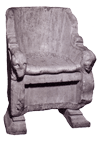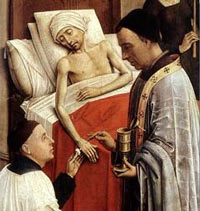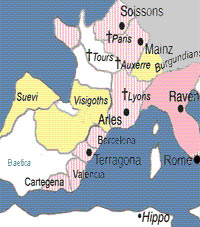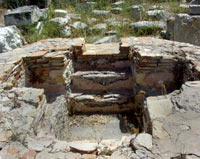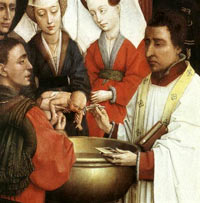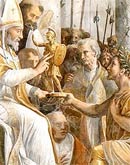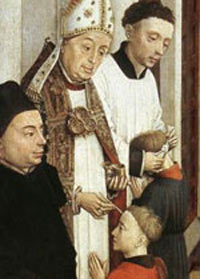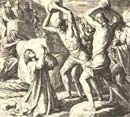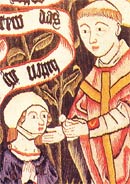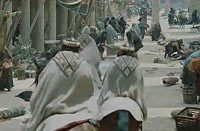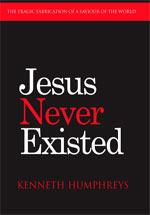The Big Chair
"Cathedra Petri" ("chair of Peter").
Actually, the throne of Pope Gregory I (540-604).
But in the 3rd century Pope Stephen I (254-257) staked his imperial pretensions on occupancy of a similar chair on which he claimed St Peter had parked his backside.
"Now don't spend it all at once."
Anointing - Roger van der Weyden (1445) Triptych of the Seven Sacraments.
'Rome' re-colonizes the west
The 5th century world in which Roman Catholicism began its bid for supreme power.
Outside the enclaves of Catholicism, "native" Christianity took non-Catholic forms.
The totalitarian inclusiveness of the Roman Church set it at loggerheads with "national" and ascetic Christians everywhere.
Who would have guessed that the "Roman Obedience" would eventually prevail?
Skinny dipping
Cruciform baptismal font, circa 5th century, Sardinia..
Before the Church achieved power baptism took place only after the candidate for conversion (a catechumen) had undergone a course of study, perhaps lasting years.When Christian belief migrated from personal conviction to legal obligation both knowledge of the faith and baptism were reduced to tokens.
Baptism - Roger van der Weyden (1445) Triptych of the Seven Sacraments.
Hocus, Pocus ... The Church very early in its existence realized that the indoctrinated child would rarely question the faith of his family and community.
If only ...
"Constantine gives Empire to Pope"
"We ordain and decree that he shall have the supremacy as well over the four principal seats, Alexandria, Antioch, Jerusalem, and Constantinople, as also over all the churches of God in the whole earth.
And the Pontiff, who at the time shall be at the head of the holy Roman church itself, shall be more exalted than, and chief over, all the priests of the whole world, and according to his judgment everything which is provided for the service of God and for the stability of the faith of Christians is to be administered."
– so-called "Donation of Constantine".
"Smile at the Bishop, sweet boy."
Confirmation - Roger van der Weyden (1445) Triptych of the Seven Sacraments.
You WILL take the sacrament!
"The mouths of communicants were held open by a wooden engine while the consecrated bread was forced down their throats, the breasts of tender virgins were either burnt with red-hot egg-shells, or inhumanly compressed between sharp and heavy boards."
– Edward Gibbon, The Decline & Fall off the Roman Empire, Ch 21.
"The abuse of Christianity introduced into the Roman government new causes of tyranny and sedition."
– Edward Gibbon, The Decline & Fall off the Roman Empire, Ch 21.
The Rackets
Eat me! Hosts and Ghosts
A priest gives communicant mouthful of holy host.
"Whoso eateth my flesh, and drinketh my blood, hath eternal life." – John 6.54.
The crooks of the cross convinced the gullible that a dry wafer was the "real presence" of Christ and its consumption was obligatory under threat of excommunication.The wine however was kept exclusive to the clergy – a practice denounced as sacrilege during the Reformation!
Hocus, Pocus ...
The Church waxed rich on the proceeds of its sex rackets.
The ceremony of marriage became a Church monopoly and the churching of children began the cycle of exploitation all over again.
The Rackets
Parasites of Salvation
From the film Agora
Born a sinner, a man could earn redemption as a criminal in the service of the Church.
Christ himself had said the only unforgivable sin was "blaspheming the Holy Spirit." (Mark 3.29).
|
Who could have imagined, at the threshold of the Dark Age in western Europe, that the paramount overlord who would eventually emerge would wear not merely the purple and gold of the caesars but also a humble fisherman's ring? Who could have anticipated that the new Augustus, who would exercise an unfettered authority from the shores of the Mediterranean to the bogs of Ireland, would rejoice in the title not only of the supreme pagan priest of Rome, Pontifex Maximus, but also that of "servant of the servants of Christ"? And yet it was the bishop on the Tiber, rather than any barbarian prince on the Rhine or the Rhone, who eclipsed all others and laid claim to the legacy of Augustus and Constantine. How could a mere churchman regain the west and triumph even in lands denied to the legions of Rome? Roman Catholicism's policy for conquest tapped resources unimagined by the caesars.
The Rackets – The Seven "Sacraments" of the Church
Roman Catholicism and Orthodoxy have seven such holy mysteries, purportedly derived from the injunctions of the Christian godman himself. Protestant reformers of the 16th century rejected that claim, insisting that only two of the sacraments had the divine seal of approval and could be vouched for by scripture: baptism and the Lord's Supper. In truth, all seven sacraments of Holy Mother Church had a single origin, and a prosaic and venal purpose: to make the parasitic priesthood indispensable to the communities on which it fed. Think of the horror of being a child unsprinkled by a priest, or dying without the babblings of a clergyman? Whilst Constantine and his successors could reward the bishops and patriarchs with palaces and all the trappings of secular power, imperial writ could not deliver the spontaneous and habitual support on which a successful tectonic shift in popular religion depended. Even the harsh rescripts of the emperors, criminalizing paganism and calling for the destruction of the ancient sanctuaries, were ineffectual for centuries in quashing the beliefs that had been held for millennia. What worked was rather more insidious and far-reaching, less of a gun-shot to the head, more of a malignant cancer, sending its tendrils and pathogens into every limb and organ of the body. According to the rationalizations of the Church, Jesus had instituted the sacraments because he knew humankind is weak and finds the path to spirituality difficult. The sacraments gave a definite, visible and tangible form to an incorporeal reality. And what was that reality? From "Mystery came Grace": it was through the holy mysteries that the promised and sought-after supernatural gift of "Grace" was delivered to the faithful. To more worldly minds, the assortment of rituals and preferments bound the community of believers into behavioural and ideological conformity and appointed to lifelong sinecures their masters, jailers and abusers. Observance of ritual, obsequiousness to the hierarchy and elimination of nonconformist opinion were the new priorities.
Gatekeeper on the door to eternity Anointing (aka "extreme unction" or last rites)
Perhaps his last thoughts were of his widow and children, entrusted to the wardship and charity of the Church, of his imminent burial in hallowed ground. Was he reassured that his widow would be instructed not to seek remarriage but to remain faithful to her spouse, "dead to this world but alive in Christ"? But what about his estate? The fact was, no sin was so bad that it could not be forgiven by the officiating priest at the moment of death and gifts to the Church voided damnation and stacked up credits in Heaven. And after all, had not the Apostle Peter brought death to Ananias and Saphira for the temerity of withholding wealth from the Church? As the near-departed took his final breaths and stood at the threshold of eternity the attending cleric would surely hear those joyous words: I leave everything to the Church.
"Donation of Constantine" In the supreme example of audacious clerical forgery of a bequest, the Roman Church produced the ultimate "deathbed legacy," purportedly made by the first Christian emperor a day or two after his baptism. It was a two-part document addressed to Pope Sylvester I in Rome. In the first part, the 'Confessio,' Constantine thanked Sylvester for his Christian instruction, baptism and a miraculous cure from leprosy! In the second part, the 'Donatio,' Constantine conferred on the pope – and his successors – primacy over all other bishops and eastern patriarchs; gave senatorial privileges and regalia to the clergy; and assigned to the Roman Church possession of imperial palaces, Rome itself and the entire western empire! In truth, this monstrous forgery (which first appeared in the mid-8th century and is peppered with anachronisms) was almost certainly written by the future pope Paul I (757-67) while his equally ambitious brother Stephen II (752-57) sat on the papal throne. The forgery was used not only by brothers Stephen and Paul but several later popes to legitimize independence of the Byzantine emperors and claim supremacy over all rivals, ecclesiastic and secular. This superlative fraud testifies to the unbridled venality of the Vicars of Christ. Estates and assets not commandeered by churchmen for their own use were leased to those who could pay a levy and the ecclesia entered the business of landlordism. Holy Mother Church, a rapacious inheritor of land, property and portable riches, waxed fat from the business of dying.
Suffer Little Children Baptism
Hitherto, Christian converts had been adults, or at least adolescents, enrolled into the ranks of the "catechumens" – trainee Christians, who had attained the "age of accountability." These probationers were slowly initiated into the holy mysteries and taught how to respond to their pagan critics. After a protracted period of induction, perhaps lasting years, the neophyte was ready for baptism and his "spiritual rebirth." It is evident from the Church Fathers (Hippolytus 'Apostolic Tradition'; Cyril of Jerusalem, 'On the Mysteries') that both men and women entered the baptismal font completely naked and early Christian art confirms this practice. He or she would be immersed totally in the sacred water and then anointed with oil by an attending priest. Thus reborn the new Christian "put on Christ," symbolized by a white garment and a lighted candle, and joined the community of the saints. Like much else, this method of making Christians originated in Egypt. The ritual supposedly prepared a sinner for a life of sinless purity and imminent Divine Judgment. It therefore made some sense that baptism should come late in life, as with Emperor Constantine himself, who waited until his deathbed and some certainty that he would no longer commit "sin." But after the Constantinian revolution, when, by degree, state power fell into the hands of the Church hierarchy, such rigor became irrelevant. The new imperative was to "gather in the flock," with little regard to individual conviction or motivation. What better way to build an all-embracing State Church than to capture young minds at birth? Nothing in the New Testament remotely sanctioned the practice of sprinkling water on babies. Forced into a corner one might turn to Paul who described baptism as "the circumcision of Christ" (Colossians 2.11). By inference, since in Jewish custom circumcision was inflicted upon an infant on his eighth day, Paul's comment could be cited to justify a similar imposition of baptism, but scarcely a convincing scriptural endorsement for a draconian policy. The notion of "infant sin" and salvation, like the very notion of "sacrament," appears to have originated in north Africa. Tertullian himself opposed the idea – but he left the Catholic Church for a purer, more committed, sect, the Montanists. But a generation later, Cyprian (200-258), another theologian of Carthage, wrote:
Catholic bishops like Augustine fled north Africa before the invading Vandals and took their new doctrine with them. In Rome the bishops enthusiastically adopted the idea, a doctrine that efficiently delivered the new born into the hands of the Church. As part of the ritual, "spiritual parents" were appointed for the infant convert, particularly where the child had been born to pagan parents. Often these "god parents" were deacons or deaconesses from the local Catholic hierarchy, intent on guiding the subsequent indoctrination of the child. An imperial edict followed, making infant baptism compulsory throughout the Roman Empire. In the penitentiary of Christendom "free will," so-called, had become a dispensation of Holy Mother Church.
Life a Penal Colony Penance (aka Confession)
By the close of the 4th century, the self-serving doctrines of "Original Sin" and "Divine Grace" were in place. The former criminalized every human who would ever live and rendered him in dire need of the latter, God's gift, dispensed solely by the henchmen of the Church. The individual believer, instilled from infancy with the certain knowledge that he was inescapably a sinner, was further instructed that without the intercession of the Church a pitiless, eternal torment awaited him. The hapless Christian was goaded to admit and voluntarily confess every possible "sin," whether in thought or deed. All transgressions were known to God anyway, and wilful non-disclosure to the confessor was itself another mortal sin. Despite the protests of heterodox Christians, Catholic orthodoxy was insistent that the individual could not remove sin by himself, no matter how pure, disciplined or "righteous" he might be. Only within the embrace of Holy Mother Church could he be "saved." The obvious venality, licentiousness and "impurity" of much of the priesthood was all too obvious to ignore. Murder itself was no bar to membership of the communion of the saints. In a clever stratagem, orthodoxy ruled that the sacraments were efficacious, even if the churchman administering them was a villain of the blackest dye, as indeed many were. Like a magic incantation learnt by rote, the sacraments acted ex opere operato – by the very fact of being performed – and were independent of the morality of the minister. Unlike the purists, who made much of the personal ethics of the priest, Catholic orthodoxy was keen to swell the ranks of the faithful above every other consideration. Thus the lapsi – those who had recanted during periods of illegality – and the traditores – those who had handed over sacred books or denounced other Christians to the pagan magistrates – were accepted back into the fold and their administered sacraments deemed valid "as long as they had followed correct ritual." Christians of a purer spirit were scandalized by such opportunism but their protests were in vain. Their communities were eventually proscribed or assimilated into the orthodox church. A willingness to confess, to show humility and avow contrition delivered the penitent into the hands of the priesthood. Churchmen became privy to human weaknesses, dark secrets and valuable confidences. Thus informed, the priest was empowered to offer – or withhold – "absolution" and set penalties. Penalties might take many forms, some public, others private or even secret. Much was made of "mortification of the flesh" and public humiliation. Milder sanctions might be "labours of prayer" and multiple Hail Marys. An enforced period of fasting on bread and water, or obligatory penitential garb, such as the hairshirt, were commonplace. The priest might order the contrite believer to make a payment (supposedly for "almsgiving to the poor" or the "service of the altar") or he might order a period of incarceration and "excommunication." The racket of confession opened a floodgate to centuries of abuse, sexual and otherwise. The scandal of priests too free with their hands ("solicitatio ad turpia") would, in a later century, force the adoption of the confessional box to afford the penitent some protection. In time, penance accrued political uses on a grand scale. Criminals could "redeem" themselves by service to the Church. They might be dispatched on pilgrimage to politically sensitive border zones, or be recruited into the ranks of the proliferating military orders. The sacrament of penance thus became a formidable instrument of social control and exploitation.
The Bishop gets his hands on the children Confirmation (aka Chrismation)
The answer was to confer "additional grace" when the communicant had "attained the use of reason." The sacrament had no divine sanction but some mileage could be squeezed out of the odd yarn in Acts 8 which reported that the deacon Philip had baptized the men and women of Samaria but that Peter and John had been required to deliver the Holy Ghost. The ritual of confirmation had little history before Pope Innocent I (401-17) decided that here was a sacrament that could be profitably administered by fellow bishops (Letter to Decentius). The adolescent to be confirmed (or "sealed") stood before his "sponsors" who placed their right foot upon his own while the bishop placed his hands upon his head and smeared his forehead with oil ("chrism"). The candidate affirmed his faith in Christ by regurgitating a memorized creed. The encounter with a noble bishop was doubtless awesome for many a youth. Presentation of the novice before the grandee no doubt exposed the potential usefulness of each to the other.
Supping with (or is it of?) the Lord Eucharist (aka Lord's Supper, Thanksgiving, Holy Communion, Mass)
Whatever the precise nature of the sacrament, which doubtless varied from city to city and between the different sects of Christians, it gave rise to scandal and accusations of immorality. As the Church moved from a fringe element of Judaism to a contender within the pagan world it moved to silence the criticisms of its detractors. Thus in the "First epistle to the Corinthians," ascribed to Paul, the apostle is at pains to stress the need in Christian gatherings for sobriety and restraint. Among other things he rails against drunkenness and fornication, women with "loose hair," and the madness of all at once speaking in "tongues." Clearly, early Christian communions had enjoyed something of a party atmosphere. "Paul" demands a quiet humility at the Lord's Supper and "Ignatius" is another "early witness" who stresses discipline and subservience to the bishop, who must always be present:
Perhaps because some believers grumbled that they were getting less, rather than more, than the old religions provided, the Church stressed the "real presence" of their god every time the sacrament was performed. Here was a better "spiritual" nourishment. The morsel of bread and the sup of wine became the very "body and blood" of Christ. The fortunate communicant imbibed the Risen Saviour on a spiritual or "mystical" level. Centuries later this miraculous transformation would be known as "transubstantiation," though the Protestant reformer Luther described the notion as "monstrous." As far as Luther was concerned Christ was simply "present." The supposed extension of the incarnation or "real presence" of the godman, into an indefinite future, everywhere that the mass was held, is surely the most extraordinary claim ever advanced by the Church. The sacrament defies rational explanation and speaks volumes about human gullibility. As a ritual, however, the Eucharist is central to the ceremonies of the Church, the regular gathering in of the flock for an obligatory dose of self-discipline, pastoral chastisement, and encouragement in the faith. If the brethren leave the communion convinced that they have yet again "received the gift of the Holy Spirit" and have been made even more fit for heaven, then the Church has achieved its purpose: marshalled ranks of dutiful and obedient servants.
The Chains of Marriage Matrimony Marriage was not, of course, invented or even practiced by Jesus, nor was it a rite especially important to the early Christians. In pre-Christian times the marriage ceremony might be sanctified by a priest but essentially mutual agreement in the presence of witnesses was the only prerequisite. A high-status wedding would involve banquets, dowries and property transfer and among the peasantry, an acclamation at a sacred grove or shrine might dignify the occasion. For the first Christians Judgment Day was imminent and in the eternal Kingdom some form of celestial celibacy would be the norm. However, in the fallen world in which Catholicism was extending its writ, marriage was both a politically and economically useful "holy sacrament," a valuable addition to its instruments of dominion. It certainly set the Catholics apart from the sectarians who appraised "purity" and wished to keep their bodies "unsullied" by carnality. In the dogmas of Holy Mother Church sexual intercourse was a concession from spiritual purity made solely in the interests of procreation. Under the bizarre smokescreen that marriage expressed "Christ's love for his Church" a ritual for Christian marriage was eventually developed, patterned after the sacrament of baptism. Led into the Church in procession, the soon-to-be-wed received blessings and solemn advice as to their duties and commitments. The raison d'être of marriage was the procreation of children, who were to be raised in the faith and would become, in turn, loyal servants of the Church. Hence a fierce opposition to the control of conception, abortion, or the exposure of infants. More babies meant more Catholics. An additional merit of marriage was what the Church charmingly described as the "quieting of concupiscence," a matter which much energized the Church Fathers. Unavoidably, indulgence in the sex act, even within marriage, meant shame and sin. But of course, the grandees of the Church knew that such sinning was as inevitable as night following day – and where there was sin there was money to be made. Sexual guilt, whether in thought or deed, required penance. Over time the Church extended its rules on "blood marriages" (consanguinity) out to a ludicrous seven generations, but not because of any concern for in-breeding (there was plenty of that). In a pre-industrial village almost everyone could be shown to have had a common ancestor. The real intent was to collect fees for dispensations to marry from anyone who had extractable wealth and, in times of times of domestic crisis, further fees to grant annulments. Marriage resulting in frequent pregnancies was an ideal, even though in pre-modern times childbirth was fraught with danger and often resulted in death of the mother. In the campaign to eradicate pre-Christian belief, royal nuptials proved especially useful, expediting mass conversions through a rapidly spreading web of strategic marriages. Catholic agents targeted wild, marginal tribes never subdued by the Romans and in a method used repeatedly by the hierarchy, a Catholic princess, typically from a tribe already won for the pope and raised on 'obedience' to Holy Mother Church, would be procured for a warrior king. Though the warlord might himself never convert, the bride would arrive with her own Catholic bishop as a "private confessor" and the offspring would be raised in the true faith under the close guardianship of a cleric. Thus were Catholic henchmen installed where it mattered most – in the heart of royal households. Through them the Church would conquer the whole of western and nothern Europe. Courtiers followed the example of their king – to do otherwise would be tantamount to rebellion. An example is provided from the Visigothic kingdom which established itself in the former Roman province of Viennensis in southwest Gaul and later expanded from Aquitaine to include most of Spain. The Gothic king Gundioc (413-473) was presented with a young bride, Caretena of the Suevi tribe. The Goths were Christians of the Arian persuasion but the Suevi had been brought into the Catholic fold some years earlier. Four sons resulted from the marriage, including Chilperic II (443-474). Chilperic became king of Burgundy and was presented with the bride Agrippine of Narbon (468-506). The issue from this marriage was a daughter Clotilda (474-545), raised a Catholic and at eighteen married on to Clovis, king of Franks, in whose bedchamber she performed outstanding service in converting the savage warrior from barbarism to the One True Faith. Other examples of strategically wedded Catholic princesses include Ingund, daughter of the Frankish king Sigebert I of Austrasia, who was packed off to Spain to marry Hermengild in 583. The subsequent conversion of her husband intensified the civil war among the Goths. Another was Bertha, daughter of Charibert, a Frankish king, who was married across the Channel to the Saxon king Aethelbert in 600, levering the Catholic church into Kent. The common peasants had no choice in the matter of conversion. A priest would arrive in a locality, with an armed escort, and all would be called to Christ. Sacred groves would be cut down, pagan sanctuaries despoiled. In many cases, a new church would be raised on an earlier cult centre, ensuring that there could be no backsliding when the evangelizing priest moved on. The fact that the old gods never struck back or saved their sanctuaries from ruin was certain evidence that Christ was the most powerful and only true god. Through the sacrament of marriage both the landed elite and the common peasantry were increasingly corralled into the vice-like grip of the Church.
Gangsters of the Cloth Holy Orders
The migration, wholesale, of Roman aristocrats into the ranks of the Church – which occurred in all provinces of the empire – was eased by the fact that social deference was unimpaired by the Christian revolution. Bishoprics, though nominally at this stage subject to "suffrage" of the entire local Christian membership, were theirs for the taking. Rule by a group of elders or presbyters, which had characterized the early church, faded from the scene, as an "overseer" (episkopos) took command. A Christian congregation might "acclaim" a figure (usually as a result of a "sign" from God) but the nominee was chosen by the existing bishops of neighbouring sees. When the land-owning elite failed to agree a candidate the result was not an election but rival bishops, each conniving by any means possible to oust his rival and often resorting to violence. For their part, poorer Christians willingly acquiesced in the nepotism in the hope for charity from a wealthy bishop. In that sense, the old Roman social order, in which an immensely wealthy patrician provided a modicum of sustenance to a vast army of slaves and artisans, continued as before. In the west, in particular, the new Church aristocrats had little interest in religion and were not well-versed in theology, for which a new language had eventually to be invented. Speaking Latin, not Greek, they were excluded from the hair-splitting disputes over doctrine that raged in the eastern empire. On every issue the Roman Church chose "mystery" over clarity; pageants and ceremonials came more naturally. Yet what the patrician-bishops lacked in religious sensibilities they compensated for with politically adroitness and skill as power-brokers. Endlessly jockeying for position and influence at the imperial court, within their own domains they devolved "pastoral" matters on deacons, sub-deacons and priests whilst they concentrated on wielding the Roman Church into a new instrument of power, aggrandizement and expansion. Even as the western empire careened towards total destruction the Church recruited, trained and disciplined a hierarchy of cadres accustomed to secular power and earthly reward.
The Gulag of Christ Between the 4th and 8th centuries the western provinces were ruined by invasion and warfare and "Roman" civilization gravitated around Constantinople, where a divine Emperor and an illustrious Patriarch reigned in oriental splendour. With the disintegration of the imperium in the west, centuries of tribal warfare followed, as petty kings, "dukes," "barons," and "counts" wrestled for lands and power. Successor states seldom extended beyond the limits of an old imperial province and were often very much smaller. A triumphant warrior might establish his rule but with frequent challenges from his own henchmen, the dynasty he might establish was likely to be short-lived. Into this unstable world the patrician-bishops and "ecclesiastical houses" intruded their existence, negotiating with the local warlord for lands rather as settlements of a later age established their presence on unknown continents. Theocratic colonies were planted or sequestered at strategic points – from Arles to Lyons and Auxerre, from Paris to Mainz, from Barcelona to Terragona and Cartegena – privileged enclaves, largely indifferent to the shifting borders and changing dynasties. Since the bishops had within their gift an awe-inspiring "romanitas," and the skills of literacy and diplomacy, they proved useful to the barbarian elite and within a generation had became part of it. With the barbarians seduced by Christ and hamstrung by the holy sacraments, the relentless gathering of power and wealth into the hands of the Church became the very essence of the "Roman Obedience." So successful were the Roman bishops that Catholic agents were able to target wild, marginal tribes never subdued by the Roman legions. By exploiting inter-tribal conflict and dynastic strife, and brokering strategic marriages, they would conquer regions of western and northern Europe that had never known the rule of a caesar.
Sources:
Copyright © 2010 by Kenneth Humphreys.
|
|||||||||||||||||||||||||||||||||||||||||||||||||
